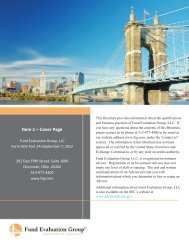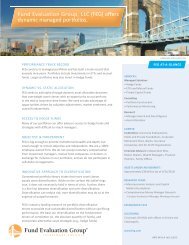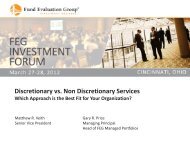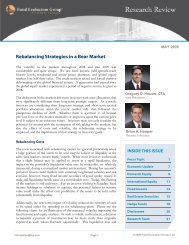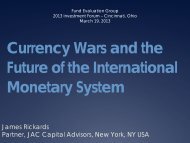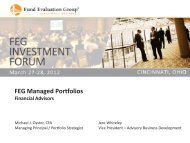download pdf - Fund Evaluation Group, LLC
download pdf - Fund Evaluation Group, LLC
download pdf - Fund Evaluation Group, LLC
You also want an ePaper? Increase the reach of your titles
YUMPU automatically turns print PDFs into web optimized ePapers that Google loves.
information@feg.com<br />
Page 4<br />
APRIL 2009<br />
In sum, the government’s reflationary efforts in current form are being used in an effort to stimulate aggregate demand<br />
in hopes of pushing aggregated demand back up and to the right. If successful, this action would shift real GDP back<br />
to the right, bringing the model to a new equilibrium.<br />
So while these efforts are reflationary, the big question for investors is not if, but when the economy recovers and banks<br />
lend again, can the Fed reduce its balance sheet, raise rates, and rein in its other lending programs quickly enough to<br />
keep the velocity of money from spinning out of control, i.e., high inflation. To put the more recent past into<br />
perspective, consider the future. Larry Summers, economic advisor to President Obama, has stated on more than one<br />
occasion that it is much easier for policy makers to overshoot and deal with the after effects later than it is to not do<br />
enough. 5 In considering how quickly the Fed has been able to act to rein in inflation following past recessions and past<br />
countercyclical efforts, the team at Grant’s is again on the case. Noting that in the prior two recessions, which met with<br />
considerably less monetary and fiscal stimulus than the current recession, those ending March 1991 and November<br />
2001, the Fed removed its accommodative stance with a significant lag. Indeed, in the recession that ended March<br />
1991, the Fed did not begin to raise rates until February 1994, and in the recession that ended November 2001, the Fed<br />
did not begin to raise rates until June 2003. 6 While nobody knows the unintended consequences of what has become<br />
the most epic of reflationary efforts in U.S. history, we believe that based on the past history of the Fed and the sheer<br />
size and scope of the various programs put into place by the government, investors should be concerned with inflation<br />
once the economy recovers.<br />
What is Inflation?<br />
Much like deflation is defined as too few dollars chasing too many goods, inflation can be defined as too many dollars<br />
chasing too few goods. Also like deflation, there is a psychological component that can be self-reinforcing. Consumers<br />
begin to believe that prices will increase and therefore increase aggregate demand. Retailers and manufacturers begin to<br />
see this increase in demand and therefore begin increasing production, paying higher wages, and ultimately raising<br />
prices. If deflation can lead to greater unemployment in an economy, then inflation can reduce unemployment in an<br />
economy.<br />
While fairly obvious to most economists and many market observers, a recent Bloomberg article posited that Federal<br />
Reserve chairman Ben Bernanke is siding with economist, and well-known counter-cyclical intervener, John Maynard<br />
Keynes against monetarist economist Milton Friedman, by flooding the financial system with money in an effort to<br />
stimulate aggregate demand. Within this article, Allan Meltzer, the Fed historian and professor of political economy at<br />
Carnegie Mellon University in Pittsburgh, noted that “if history is any guide, the Fed’s effort will end in tears and<br />
inflation will be higher than it was in the 1970s. At the end of that decade, consumer prices rose at a year-over-year rate<br />
of 13.3%.” 7<br />
As mentioned earlier, the Federal Reserve has increased its balance sheet dramatically, and its subsequent monetization<br />
of the government’s debt obligations through its Treasury purchases (known more fondly as quantitative easing) are<br />
akin to printing money. Additionally, the M1 (currency, traveler’s checks, demand deposits, and other checkable<br />
deposits) and M2 (M1 plus retail money market funds, savings, and small time deposits) money stock measures, as<br />
reported by the Federal Reserve, have grown considerably on a seasonally adjusted basis since the beginning of the<br />
recession. M1 has grown by 14.5%, to $1.6 trillion, and M2 has grown by 12.2% to $8.3 trillion. As economist Milton<br />
Friedman said “inflation is always and everywhere a monetary phenomenon” and the growth of the monetary stock is<br />
indeed on the rise and shows no immediate sign of slowing.<br />
© 2009 <strong>Fund</strong> <strong>Evaluation</strong> <strong>Group</strong>, <strong>LLC</strong>



